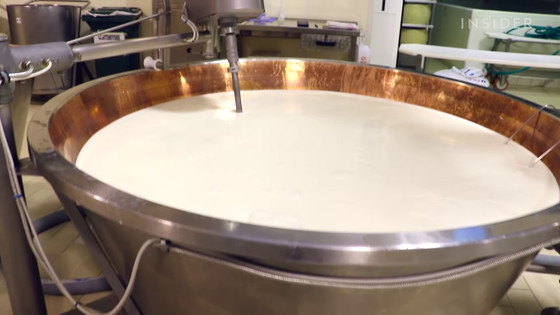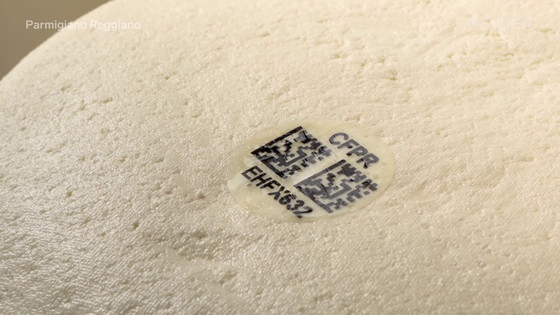What is the reason why the king of Italian cheese 'Parmigiano Reggiano' is expensive?

Parmigiano Reggiano, which is indispensable for authentic Italian cuisine, is a representative cheese in Italy and is also known as a very expensive cheese, so-called "the king of Italian cheese". FOOD INSIDER introduces movies in why Parmigiano Reggiano is high priced and introduces the manufacturing process of various foods.
Why Parmesan Cheese Is So Expensive - YouTube
Parmigiano Reggiano is one of the most important exports for Italy and its market value is said to be equivalent to 2.2 billion euros (about 280 billion yen).

Parmigiano Reggiano is made in a specific area such as Parma of Emilia Romana State and Reggio Emilia, and only the one which was certified by the Place of Origin Name Protection System called Denomi Nazione di Oligine Protector (DOP) is "Parmigiano · Reggiano "officially allowed to be claimed.

It is said that it was over 1,000 years old that he made Parmigiano Reggiano for the first time. The raw material of Parmigiano Reggiano is milk and salt of cow, and only the curd enzyme that can be taken from the stomach of a cow called " rennet ".

It is said that it is difficult to make similar Parmigiano Reggiano in areas other than production areas such as Emilia Romana. One of the reasons is that it is said that three kinds of bacteria that live only in specific areas are indispensable for production.

According to Nicolas Bertinelli who is making Parmigiano Reggiano, when cattle eat pasture they take bacteria alive in the stomach and bacteria breed in the stomach. In addition, this bacterium lives also in milk, and if there is no fermentation by this bacterium it says that the fragrance and taste of Palmigiano Reggiano is not born.

It is said that 131 gallons (about 500 liters) of milk is needed to make 1 hole of Parmigiano Reggiano. You can make only once a day to use milk mixed with fresh ingredients squeezed in the morning of the morning, one that puts the fat over the night and separates it.

Milk gradually becomes like yoghurt by adding rennet while stirring in a huge copper pot.

The temperature of the pot is 38 degrees to 55 degrees and the cheese making craftsman stirs every day with a unique shaped tool called "Spino", and the milk in the copper pot dries from a yoghurt-like, I will skim the moisture while coagulating until it has elasticity like. To ensure that the moisture is thoroughly blown, so that cheese can be stored for a long time.


The coagulated milk (card) accumulates in the bottom of the pot, so it is done with linen cloth ... ...

Just tap on the sticks and dry as much as possible to drain the moisture.

Then put the card into the mold with linen cloth.

Linen cloth is replaced every 2 hours.

When it is 8:00 pm, win a pattern paper engraved with the name of the producer or production place and imprint the surface.


The basic way of making it has not changed since the monk made 1000 years ago, but modern technology also applies. An ID is issued for each hole of cheese, and you can confirm from when it is made on the spot on the spot.


After about 4 days, remove the paper pattern and salt in the salt water for about 19 days.

Put the cheese on the shelf after pulling it out of the salt water, and perform aging while drying.

Cheese on aging shelf will not be touched at all for 1 year. After one year, cheese is lowered from the shelf, and while the craftsman hits with a hammer, it checks dry condition and bubbles.

Cheese that was deemed to be fully dried and matured is pushed to the side and can be further burned. This completes the cheese. Parmigiano Reggiano can only be made one day and it will cost a lot higher than other cheese because it takes a lot of time and effort to complete it.


Approximately 18 months to 36 months for cheese ripening, more than 10 years for long things. The longer the maturation becomes, the higher the price of the cheese increases. For example, Parmigiano Reggiano aged for three years may have a market price of $ 15 (about 1700 yen) around 1 pound (about 450 grams). Because the long aged Parmigiano Reggiano 1 hole is very high value by itself, some Italian banks offer loans for cheese traders with collateral of Parmigiano Reggiano. The corresponding bank seems to be equipped with a warehouse that matures Parmigiano Reggiano.

The fact that the aging period cooperates with the soaring price implies that there is no black market for counterfeit Parmigiano Reggiano. The Italian government has been fighting for years from the market to eliminate the falsehood of Parmigiano Reggiano. The long history of Parmigiano Reggiano is also a fight against counterfeit goods. Not only Parmigiano Reggiano, cheeses produced in Europe are strongly protected by the EU.

Bertinelli says "In many countries around the world" Parmigiano Reggiano "is trademarked and the designation" Parmesan cheese "tricks cheese which is not Parmigiano Reggiano to Parmigiano Reggiano This problem is very big and the Italian government is still working on it. " Powdered cheese sold in Japan is often called "Parmesan cheese", but in fact it is totally different from real palmigano · reggano.

The genuine Parmigiano Reggiano has a mark like the image below that surely comes. When purchasing Parmigiano Reggiano in a supermarket etc., it is recommended to check on the store to ensure that the mark is displayed properly by hand.

Related Posts:







